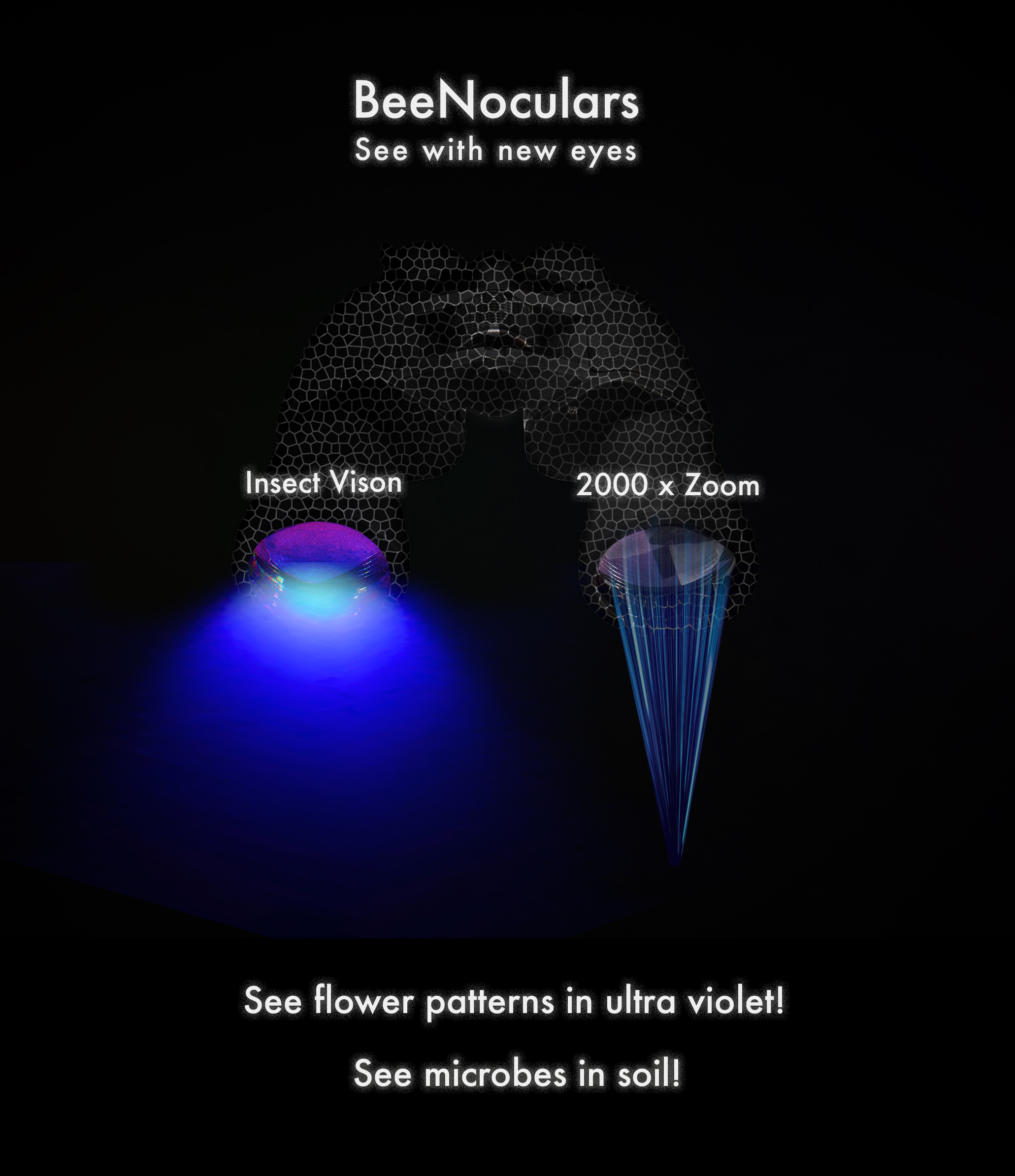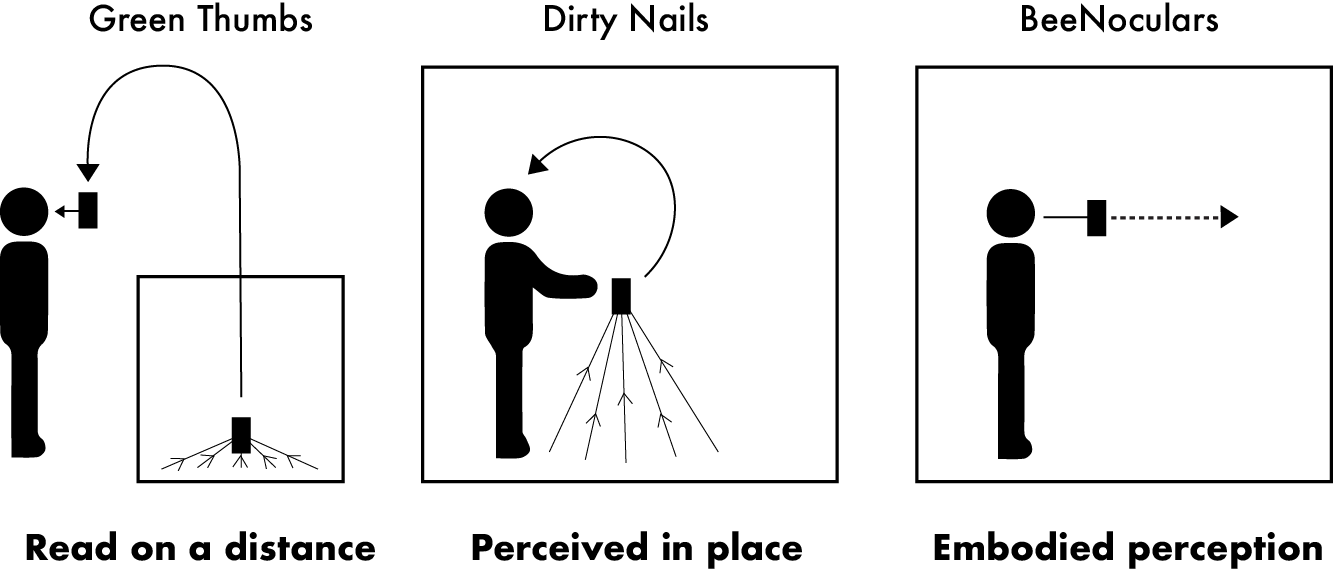BeeNoculars
This project explored how speculative design can further findings from an ethnographic participant observation study of urban community farmers. The speculative designs point to possible futures, that each highlight different needs, values, norms, behaviors and attitudes of urban community farmers. Three approaches to cultivation are highlighted with a corresponding design (1) the approach of “Controlling” through the Green Thumbs design (2) the approach of “Sensibility” through the Dirty Nails design and (3) The approach of “Appreciating” through the BeeNoculars design. All three speculative designs focus on the possibilities of sensing technologies to support the noticing of environmental conditions. This project is discussed in more detail in the NordiCHI paper"Noticing the Environment – A Design Ethnography of Urban Farming".
Design Description
BeeNoculars enables users to see aspects of the cultivation that cannot be experienced solely with the human senses. The first mode of seeing visualizes the ultraviolet (UV) spectra, revealing for example UV-patterns on flowers. The second mode of seeing microscopically zooms up to 2000 times enabling for example the study of microbes in soil.

The BeeNoculars
speculative design poster, as shown to the participants.
Grounding in community practices of ‘appreciating ’
The BeeNoculars design is based on an approach to gardning that I frame as ‘apreciating’ gardens with all senses (the somatic experience). I found that many urban farmers valued relaxation and ‘just being’ in the cultivation. This was expressed for examples through signs placed in the urban farm stating “space for meditation”.Further, many urban farmers valued exploration and experimentation for its own sake, motivated by experiences such as beauty. In these aproaches, the goal was not to produce anything. Given these practices, the intention of designing BeeNoculars, was to create an open-ended tool that expanded sensory perception, with a particular focus on appreciating the aesthetic aspects of this experience.
Participant responses
The urban farmers expressed that it would be “super fun” (M1), “interesting” (W1, M2) and “exiting” (W2) to see flower patterns in ultraviolet. Simultaneously, they were struggling with prescribing the UV-vision practical meaning: “ultraviolet, I actually don’t know what value it can have” (M1). Neverhtelss, others saw value beyond concreate instrumental use “this shows just how precious flowers are. It’s so magical that you want to grow even more” (W2).
The name (BeeNoculars) and short text of the design presentation (Insect Vision) highlighted UV-vision as a capacity of bees. This was recognized by one participant who expressed that it was “interesting to see the world as a bee, in some ways they know more than us” (W2).
While reactions to the UV-vison were scattered, all participants found the microscope functionality more directly “useful” (M2), “you will perhaps be able to see microbes. If you get better at seeing what functions they have in the soil, it can also have a purpose” (M1).
One cultivator further discussed the potential benefits of using Green Thumbs and BeeNoculars together, since this would couple “causal relationships” (M1) between an observed phenomenon (e.g., composition of soil microbes) with sensor data (e.g., nutrient levels) “like, if you would use them together you would learn these kinds of causal relationships /…/ If you use them together long enough you would eventually, just through using BeeNoculars, be able to predict [the health of the soil]” (M1).
Expanding perceptions of entangled ecologies
BeeNoculars expands perceptions of the world beyond the capacity of human senses. This has both practical and experiential value. For example, the ability for humans to see UV-patterns on flowers may have a purpose in how apricating the beauty of a flower can increase the motivation for taking care of it, and in extension the whole ecology. This was recognized by some urban framers, but not all. Relatedly, the design embodies an idea that users may empathize with bees not only on an intellectual plane (e.g., through an awareness of the negative effects of habitat loss and toxins) but trough considering the actual experience of being a bee. Some of the reactions of the participants suggest that an embodied understanding of other beings’ different perceptions of the world could support the appreciation of them.
Further, the shift in scale enabled by the microscope was rconnized to have a broad range of uses in a cultivation context. Based on the ethnographic findings, the speculative design presentation particularly highlights the noticing of soil bacteria that affects decomposition of soil nutrients and have health implications for both plants and humans. This use of microscopic vison requires deep knowledge to meaningfully guide actions of care in the cultivation. The findings indicate that some urban farmers were willing to invest this time and effort to examine soil.
On a more general level, BeeNoculars highlights how humans are entangled with ecologies, and that we should appreciate these entanglements and take responsibility for them. Some entanglements are material, such as the recycling of nutrients through composting, while other entanglements are more emotional. The urban farmers used figures of entanglements to frame their practice, for example expressing “you become totally religious from reading about the network in soil. It feels like it will solve everything” (W1). I suggest that the BeeNoculars design could make this figure of entanglements more grounded in actual experience through enabling observation of interspecies entanglements in soil.
As pointed out by Liu et al [57] this relational perspective frames cultivation as a practice characterized by multiple systems in constant evolvement and change, rather than one cohesive system with a set of fixed parameters. This pose challenges for computational technologies that usually build on sensing and visualizing clearly defined parameters (e.g., Green Thumbs). In contrast, BeeNoculars illustrates how cultivations can be viewed less as cohesive systems with fixed parameters and more as ecologies characterized by multiple self-modifying systems in constant evolvement and change, with interconnecting variables that cannot be isolated. In such systems, situated and particular noticing may perform better than any amount of ‘data mining’.
Critical reflection
Several participants struggled to give the UV-vison practical meaning. This illustrates how more aesthetic or emotional motives for cultivation were often downplayed when the urban farmers discussed their practice. Nevertheless, the observations indicate that aesthetics and emotion were highly present as implicit motives for participating in the urban farming community. I suggest that speculative design can be one way to let users reflect on more emotional and aesthetic aspect of their practice.
Further, the inclusion of two different functions in the same design caused some confusion in terms of illustrating the approach of ‘appreciating’ cultivation. Firstly, this created initial confusion in terms of clarity of the speculative design image “Like, is there one [mode of seeing] on each side?” (M1). I had to explain to the participants that I imagined a toggling between the two modes of seeing. Secondly, the two modes of seeing actually illustrated two different approaches. The participant reflections on the UV-vision most clearly illustrated the aesthetic appreciation of cultivation (that I set out to design for), while reflections on the microscopic vison had more practical character, aligning more with the approach of ‘developing a sensibility’ or even ‘controlling’. However, this is not necessarily a flaw of the speculative design, as it instead illustrates how the approaches overlap, and aesthetic appreciation and practical purposes often co-exist in cultivation practice.
Lastly, one participant imagined a combination of several of the speculative designs. I had not considered this possibility. This illustrates how the participants were triggered by the speculative designs to ideate on potential use cases, but also how a plurality of approaches and tools might be the most preferable future.

Comparing the relations to the environment that the speculative designs illustrate.